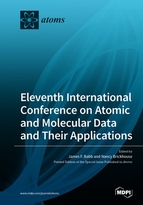Eleventh International Conference on Atomic and Molecular Data and Their Applications
A special issue of Atoms (ISSN 2218-2004).
Deadline for manuscript submissions: closed (30 June 2019) | Viewed by 22149
Special Issue Editors
Interests: atomic and molecular structure; astrophysical applications of atomic and molecular physics; Casimir; relativistic; and quantum electrodynamics effects in atoms and molecules; long-range forces
Interests: plasma physics; solar and stellar coronae; plasma emission line spectroscopy; ultraviolet and X-ray spectroscopy of astrophysical sources; laboratory astrophysics
Special Issue Information
Dear Colleagues,
ICAMDATA 2018 (Cambridge, MA) continues the series of international conferences since 1997 promoting the use of atomic and molecular (AM) data in various fields of science and technology, and provides the principal forum for interaction between AM data producers, data users, data compilers, and database developers. The conference will cover topics including:
I. Application and needs of atomic and molecular data:Astrophysics and atmospheric physics, Inertial and magnetic fusion, Low and high temperature laboratory plasma and industrial plasmas, Lighting sciences and technology, Biomedicine and biophysics, Combustion and environmental sciences and technology, Surface physics, gaseous electronics, solid state optics and spectroscopy, optoelectronics, etc.
II. Atomic and molecular data production: Data collection, assessment, exchange and dissemination, Standardization of data formats, AM databases, Activities of data centers.III. Experimental and theoretical methods for atomic and molecular data generation, Atomic and molecular structure, spectroscopy and radiative processes, Electron and photon collisions with atoms and molecules, Heavy particle collisions, Particle–surface interactions.
Dr. James Babb
Dr. Nancy Brickhouse
Guest Editors
Manuscript Submission Information
Manuscripts should be submitted online at www.mdpi.com by registering and logging in to this website. Once you are registered, click here to go to the submission form. Manuscripts can be submitted until the deadline. All papers will be peer-reviewed. Accepted papers will be published continuously in the journal (as soon as accepted) and will be listed together on the special issue website. Research articles, review articles as well as short communications are invited. For planned papers, a title and short abstract (about 100 words) can be sent to the Editorial Office for announcement on this website.
Submitted manuscripts should not have been published previously, nor be under consideration for publication elsewhere (except conference proceedings papers). All manuscripts are thoroughly refereed through a single-blind peer-review process. A guide for authors and other relevant information for submission of manuscripts is available on the Instructions for Authors page. Atoms is an international peer-reviewed open access quarterly journal published by MDPI.
Please visit the Instructions for Authors page before submitting a manuscript. The Article Processing Charge (APC) for publication in this open access journal is 350 CHF (Swiss Francs). We will waive the APC for this special issue and publish all the papers free of charge. Submitted papers should be well formatted and use good English. Authors may use MDPI's English editing service prior to publication or during author revisions.
Keywords
- atomic data
- plasma technology
- plasma chemistry
- EUV lithography
- astrophysics
- spectroscopy
- molecular data
- atomic structure
- electron collisions
- heavy particle collisions
- stellar opacity
- planetary atmospheres







